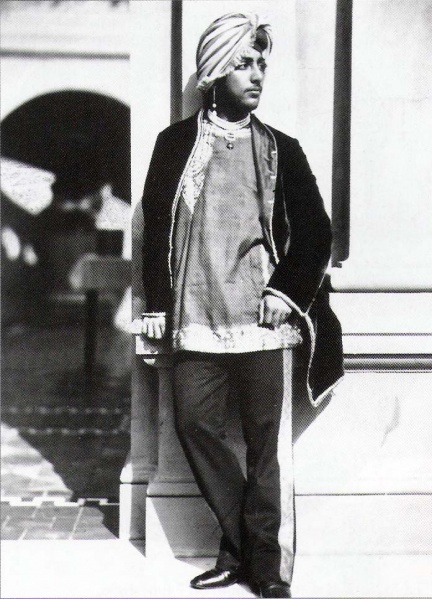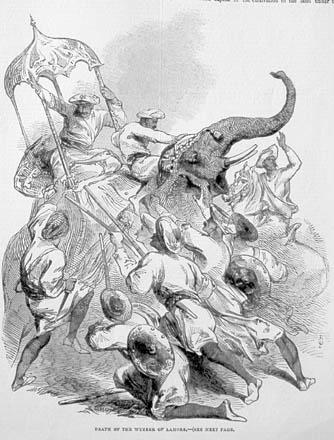|
Duleep Singh
Maharaja Sir Duleep Singh, GCSI (4 September 1838 – 22 October 1893), or Sir Dalip Singh, and later in life nicknamed the "Black Prince of Perthshire", was the last ''Maharaja'' of the Sikh Empire. He was Maharaja Ranjit Singh's youngest son, the only child of Maharani Jind Kaur. He was placed in power in September 1843, at the age of five, with his mother ruling on his behalf, and after their defeat in the Anglo-Sikh War, under a British Resident. He was subsequently deposed by the British Crown, and thereafter exiled to Britain at age 15 where he was befriended by Queen Victoria, who is reported to have written of the Punjabi Maharaja: "Those eyes and those teeth are too beautiful".Eton, the Raj and modern India By Alastair Lawson; 9 March 2005; BBC News. The Queen was godmother to several of his children. [...More Info...] [...Related Items...] OR: [Wikipedia] [Google] [Baidu] |
Bamba Müller
Maharani Bamba, Lady Duleep Singh (born Bamba Müller; 6 July 1848 – 18 September 1887), was the Egyptian wife of Maharaja Sir Duleep Singh. Brought up by Christian missionaries, she married Sir Duleep Singh and became Maharani Bamba, wife of the last Maharaja of Lahore. Her transformation from illegitimate girl, born to a German father and Abyssinian (Ethiopian) mother, living in a Cairo mission to a Maharani living a life of luxury with the "Black Prince of Perthshire" has been compared to the "Cinderella" story. Biography Bamba Müller was the daughter of Ludwig Müller, a German merchant banker with the company Todd Müller and Co., by his mistress of Abyssinian descent called Sofia.Maharani Bamba Duleep Singh , DuleepSingh.com, accessed March 2010 The name Bamba was Arabic for ''pink''. Her father already ... [...More Info...] [...Related Items...] OR: [Wikipedia] [Google] [Baidu] |
Maharaja
Mahārāja (; also spelled Maharajah, Maharaj) is a Sanskrit title for a "great ruler", "great king" or " high king". A few ruled states informally called empires, including ruler raja Sri Gupta, founder of the ancient Indian Gupta Empire, and Chandragupta Maurya. 'Title inflation' soon led to most being rather mediocre or even petty in real power, which led to compound titles (among other efforts) being used in an attempt to distinguish some among their ranks. The female equivalent, Maharani (or Maharanee, Mahārājñī, Maharajin), denotes either the wife of a Maharaja (or Maharana etc.) or also, in states where it was customary, a woman ruling without a husband. The widow of a Maharaja is known as a Rajmata, "queen mother". Maharajakumar generally denotes a son of a Maharaja, but more specific titulatures are often used at each court, including Yuvaraja for the heir (the crown prince). The form "Maharaj" (without "-a") indicates a separation of noble and religious o ... [...More Info...] [...Related Items...] OR: [Wikipedia] [Google] [Baidu] |
Maharaja Ranjit Singh
Ranjit Singh (13 November 1780 – 27 June 1839), popularly known as Sher-e-Punjab or "Lion of Punjab", was the first Maharaja of the Sikh Empire, which ruled the northwest Indian subcontinent in the early half of the 19th century. He survived smallpox in infancy but lost sight in his left eye. He fought his first battle alongside his father at age 10. After his father died, he fought several wars to expel the Afghans in his teenage years and was proclaimed as the "Maharaja of Punjab" at age 21. His empire grew in the Punjab region under his leadership through 1839. Prior to his rise, the Punjab region had numerous warring misls (confederacies), twelve of which were under Sikh rulers and one Muslim. Ranjit Singh successfully absorbed and united the Sikh misls and took over other local kingdoms to create the Sikh Empire. He repeatedly defeated invasions by outside armies, particularly those arriving from Afghanistan, and established friendly relations with the British. ... [...More Info...] [...Related Items...] OR: [Wikipedia] [Google] [Baidu] |
British Crown
The Crown is the state in all its aspects within the jurisprudence of the Commonwealth realms and their subdivisions (such as the Crown Dependencies, overseas territories, provinces, or states). Legally ill-defined, the term has different meanings depending on context. It is used to designate the monarch in either a personal capacity, as Head of the Commonwealth, or as the king or queen of their realms (whereas the monarchy of the United Kingdom and the monarchy of Canada, for example, are distinct although they are in personal union). It can also refer to the rule of law; however, in common parlance 'The Crown' refers to the functions of government and the civil service. Thus, in the United Kingdom (one of the Commonwealth realms), the government of the United Kingdom can be distinguished from the Crown and the state, in precise usage, although the distinction is not always relevant in broad or casual usage. A corporation sole, the Crown is the legal embodiment of ex ... [...More Info...] [...Related Items...] OR: [Wikipedia] [Google] [Baidu] |
British Resident
A resident minister, or resident for short, is a government official required to take up permanent residence in another country. A representative of his government, he officially has diplomatic functions which are often seen as a form of indirect rule. A resident usually heads an administrative area called a residency. "Resident" may also refer to resident spy, the chief of an espionage operations base. Resident ministers This full style occurred commonly as a diplomatic rank for the head of a mission ranking just below envoy, usually reflecting the relatively low status of the states of origin and/or residency, or else difficult relations. On occasion, the resident minister's role could become extremely important, as when in 1806 the Bourbon king Ferdinand IV fled his Kingdom of Naples, and Lord William Bentinck, the British Resident, authored (1812) a new and relatively liberal constitution. Residents could also be posted to nations which had significant foreign influe ... [...More Info...] [...Related Items...] OR: [Wikipedia] [Google] [Baidu] |
Second Anglo-Sikh War
The Second Anglo-Sikh War was a military conflict between the Sikh Empire and the British East India Company that took place in 1848 and 1849. It resulted in the fall of the Sikh Empire, and the annexation of the Punjab and what subsequently became the North-West Frontier Province, by the East India Company. On 19 April 1848 Patrick Vans Agnew of the civil service and Lieutenant William Anderson of the Bombay European regiment, having been sent to take charge of Multan from Diwan Mulraj Chopra, were murdered there, and within a short time the Sikh troops joined in open rebellion. Governor-General of India Lord Dalhousie agreed with Sir Hugh Gough, the commander-in-chief, that the British East India Company's military forces were neither adequately equipped with transport and supplies, nor otherwise prepared to take the field immediately. He also foresaw the spread of the rebellion, and the necessity that must arise, not merely for the capture of Multan, but also for the ent ... [...More Info...] [...Related Items...] OR: [Wikipedia] [Google] [Baidu] |
Jind Kaur
Maharani Jind Kaur ( – 1 August 1863) was regent of the Sikh Empire from 1843 until 1846. She was the youngest wife of the first Maharaja of the Sikh Empire, Ranjit Singh, and the mother of the last Maharaja, Duleep Singh. She was renowned for her beauty, energy and strength of purpose and was popularly known as ''Rani Jindan'', but her fame is derived chiefly from the fear she engendered in the British in India, who described her as "the Messalina of the Punjab". After the assassinations of Ranjit Singh's first three successors, Duleep Singh came to power in September 1843 at the age of 5 and Jind Kaur became Regent on her son's behalf. After the Sikhs lost the First Anglo-Sikh War she was replaced in December 1846 by a Council of Regency, under the control of a British Resident. However, her power and influence continued and, to counter this, the British imprisoned and exiled her. Over thirteen years passed before she was again permitted to see her son, who was taken t ... [...More Info...] [...Related Items...] OR: [Wikipedia] [Google] [Baidu] |
Ranjit Singh
Ranjit Singh (13 November 1780 – 27 June 1839), popularly known as Sher-e-Punjab or "Lion of Punjab", was the first Maharaja of the Sikh Empire, which ruled the northwest Indian subcontinent in the early half of the 19th century. He survived smallpox in infancy but lost sight in his left eye. He fought his first battle alongside his father at age 10. After his father died, he fought several wars to expel the Afghans in his teenage years and was proclaimed as the "Maharaja of Punjab" at age 21. His empire grew in the Punjab region under his leadership through 1839. Prior to his rise, the Punjab region had numerous warring misls (confederacies), twelve of which were under Sikh rulers and one Muslim. Ranjit Singh successfully absorbed and united the Sikh misls and took over other local kingdoms to create the Sikh Empire. He repeatedly defeated invasions by outside armies, particularly those arriving from Afghanistan, and established friendly relations with the British ... [...More Info...] [...Related Items...] OR: [Wikipedia] [Google] [Baidu] |
Perthshire
Perthshire ( locally: ; gd, Siorrachd Pheairt), officially the County of Perth, is a historic county and registration county in central Scotland. Geographically it extends from Strathmore in the east, to the Pass of Drumochter in the north, Rannoch Moor and Ben Lui in the west, and Aberfoyle in the south; it borders the counties of Inverness-shire and Aberdeenshire to the north, Angus to the east, Fife, Kinross-shire, Clackmannanshire, Stirlingshire and Dunbartonshire to the south and Argyllshire to the west. It was a local government county from 1890 to 1930. Perthshire is known as the "big county", or "the Shire", due to its roundness and status as the fourth largest historic county in Scotland. It has a wide variety of landscapes, from the rich agricultural straths in the east, to the high mountains of the southern Highlands. Administrative history Perthshire was an administrative county between 1890 and 1975, governed by a county council. Initially, Perthsh ... [...More Info...] [...Related Items...] OR: [Wikipedia] [Google] [Baidu] |
Order Of The Star Of India
The Most Exalted Order of the Star of India is an order of chivalry founded by Queen Victoria in 1861. The Order includes members of three classes: # Knight Grand Commander ( GCSI) # Knight Commander ( KCSI) # Companion ( CSI) No appointments have been made since the 1948 New Year Honours, shortly after the Partition of India in 1947. With the death in 2009 of the last surviving knight, the Maharaja of Alwar, the order became dormant. The motto of the order was "Heaven's Light Our Guide". The Star of India emblem, the insignia of order and the informal emblem of British India, was also used as the basis of a series of flags to represent the Indian Empire. The order was the fifth most senior British order of chivalry, following the Order of the Garter, Order of the Thistle, Order of St Patrick and Order of the Bath. It is the senior order of chivalry associated with the British Raj; junior to it is the Most Eminent Order of the Indian Empire, and there is also, for ... [...More Info...] [...Related Items...] OR: [Wikipedia] [Google] [Baidu] |



.jpg)


